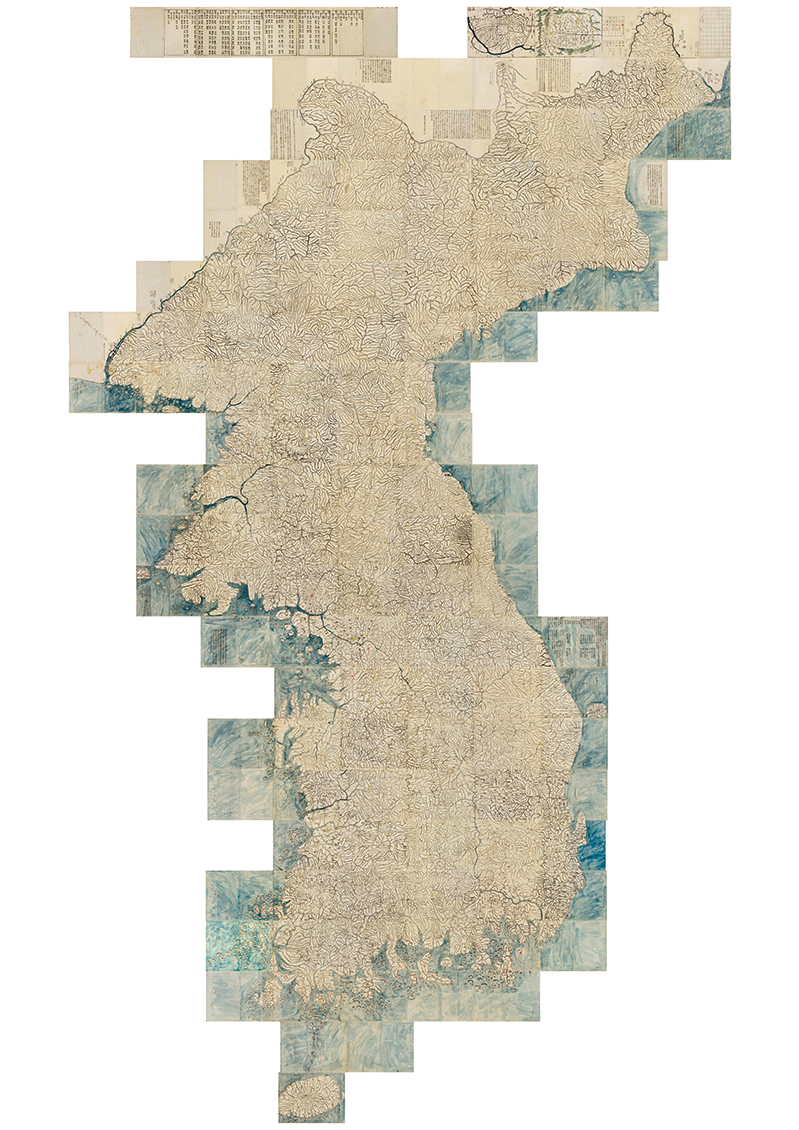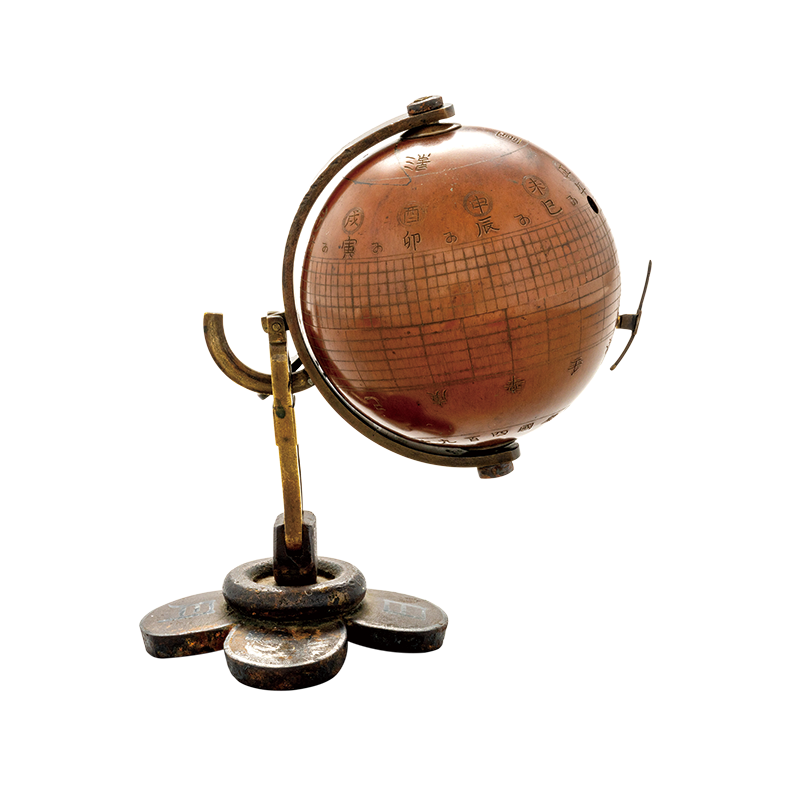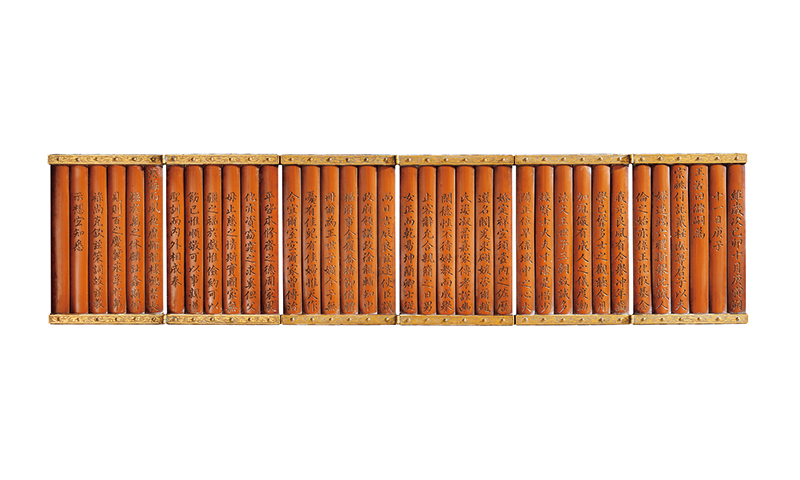It is estimated that, as of January 2023, almost 230,000 Korean cultural properties were located outside Korea. Since its establishment in 2012, the Overseas Korean Cultural Heritage Foundation (OKCHF) has recovered nearly 2,500 such s through donations and acquisitions, with artifacts of historical and artistic value designated as cultural treasures.
Lotus Sutra Vol. 6. Circa 14th century. Indigo paper, gold and silver paint. 27.6 × 9.5 cm (folded), 27.6 × 1,070 cm (spread out), 1.65 cm thick.
Produced in the Goryeo Dynasty and consisting of illustrations and transcriptions of the Buddhist scriptures, volume six of the Lotus Sutra was retrieved from Japan in March 2023. The text preaches that the path to becoming Buddha is open to anyone and had a major influence on the adoption of Buddhist philosophy in Korea.
© National Palace Museum of Korea
In July 2023, the Overseas Korean Cultural Heritage Foundation (OKCHF) received a donation of 1,516 s from the private collection of Gary Edward and Mary Ann Mintier, two former Peace Corps volunteers from the United States with a deep love for Korean culture. The s included modern and contemporary artworks, books, and photographs of Korea taken by the couple while they worked as English teachers in Seoul and Busan between 1969 and 1975.
Among the donated s were rare and valuable artifacts that offer insight into the diversity of modern paintings. Photographs capturing Busan’s landscape and the daily lives of the city’s residents provide a vivid record of Korea’s modern history. To celebrate the donation, the Busan Museum held a month-long special exhibition titled 1970 Busan: A Glimpse of Normal Daily Life.

Territorial Map of the Great East. 19th century. 30 × 20 cm (individual booklet), approx. 6.7 × 4 m (spread out).
The Territorial Map of the Great East was produced and published by Joseon geographer Kim Jeong-ho in 1861, and then republished three years later after partial revisions. The map that was recently recovered is the 1864 edition and includes content from Atlas of the Eastern State, another map of the Korean peninsula produced by Kim, thus providing more detailed geographical information. It is composed of 23 booklets, including the index.
Courtesy of Cultural Heritage Administration
Recovery via Donations
Established in 2012, the OKCHF is responsible for assessing the status of cultural properties that have been taken out of the country for a variety of reasons. The organization also supports the conservation, management, research, and use of these artifacts in museums and art galleries outside Korea, as well as the recovery of displaced s through donations or acquisitions. According to the OKCHF, as of January 2023, a total of 229,655 Korean cultural properties were held in 27 countries, with the lion’s share in Japan (95,000) and the United States (65,000).
The recovery of cultural properties taken from Korea is a highly complex and challenging process. Should a person, institution, or country in possession of an artifact simply refuse to return it, the options are extremely limited. Even if items were taken by illegal means, current international law makes recoveries very difficult. Displaced cultural properties can find their way back to Korea in several ways: as donations by individuals, institutions, or countries; through diplomatic negotiations; as acquisitions through auctions or private transactions; or as de facto returns in the form of long-term leases. Among these, charitable donations made by collectors are the most common. In the 11 years since the founding of the OKCHF, 1,204 recoveries have taken place, involving 2,482 s, the majority of which have been donated. The act of donating cultural artifacts—which takes time, money, and effort to collect—is both commendable and noble.
Among the cultural properties that have been returned to Korea are several that have been designated as cultural treasures because of their historical, academic, and artistic value. A notable example is the Buncheong Memorial Tablet of Yi Seon-je with Inlaid Inscription of the “Fifth Gyeongtae Year” (Buncheongsagi sanggam “gyeongtae 5-nyeonmyeong” Yi Seon-je myoji). The tablet bears the name, social status, and career of Yi Seon-je (1390–1453), a scholar at the Hall of Worthies (Jiphyeonjeon). This royal research institute was established in 1420 by King Sejong (r. 1418–1450) but disbanded in 1456 by King Sejo (r. 1455–1468). The piece was designated as treasure because it exemplifies the characteristics of memorial tablets of early Joseon, a transition period for these tablets in terms of their materials and design. The tablet was in the possession of Japanese art collector Tadashi Todoroki until his death in 2017, when his wife, Kunie Todoroki, decided to return it to Korea.

Spherical Sundial. 1890. Copper, iron. Height 23.8 cm, globe diameter 11.2 cm.
The Spherical Sundial is a valuable artifact that demonstrates the dynasty’s advanced scientific and technological expertise. Whereas most Joseon sundials had a hemispheric shape, this particular example is globular and propped up on a stem and petal-shaped base. It was acquired at an auction held in the United States in March 2022.
© National Palace Museum of Korea
Rare Artifacts
Two recently recovered cultural properties are particularly noteworthy: the Territorial Map of the Great East (Daedong yeojido) from the second half of the Joseon Dynasty (1392–1910) and the sixth volume of the Lotus Sutra from the Goryeo Dynasty (918–1392).
The map that was recovered is considered to be of even greater historical value because its composition and content differ from others currently held by Korean institutions. The map is a combination of an 1864 edition and another map, the Atlas of the Eastern State (Dongyeodo), both produced by noted Joseon geographer and cartographer Kim Jeong-ho (c. 1804–c. 1866). The OKCHF acquired theafter it learned of its existence when a Japanese collector put it up for sale.
Sutras are meticulous, elaborately decorated handwritten copies of sacred texts, and the sixth volume of the Lotus Sutra is a partial transcription of what is considered to be the final teachings of Siddharta Gautama, the founder of the Buddhist faith. Geumni and eunni, traditional paints made by mixing gold and silver powders with oxhide glue, were used to illustrate and transcribe the text on mulberry paper, which was dyed with indigo extracted from the leaves of dyer’s knotweed, a traditional Korean dye still used today. This rare artifact was returned to Korea when a Japanese collector expressed a desire to sell it to the OKCHF.
Of the ten artifacts recovered in 2022, the 19th-century Spherical Sundial (Iryeongwongu) attracted the most attention. The first of its kind ever to be discovered, the intricately designed, portable sundial, with a diameter of just over 11 centimeters, demonstrates the Joseon Dynasty’s advanced level of science and artistry. Remarkable, too, is that an inscription on one of the hemispheres indicates that it was d in 1890 by Sang Jik-hyeon, a military officer during the reign of King Gojong (r. 1864–1907). After a private collector put it up for auction in the United States, the OKCHF won the bid and brought it back to Korea.
Designation as Treasures
Two other artifacts that were recently recovered by the OKCHF and designated as cultural treasures are the 16th-century painting Gathering of Officials at Dokseodang Study (Dokseodang gyehoedo) and the Royal Bamboo Investiture Book Installing Queen Sinjeong as Crown Prince’s Consort (Munjobi Sinjeong wanghu wangsejabin chaekbong jukchaek).
“Gyehoedo” refers to a genre of Joseon era paintings that depict gatherings of officials or scholars. This particular example is believed to have been commissioned in or around 1531, as it contains the names and positions of the gathered government officials about whom records exist in the Annals of King Jungjong (Jungjong sillok). The painting was also acquired at an auction in the United States after a Japanese collector had put it up for sale.
The bamboo investiture book was purchased in 2018 by the Korean branch of U.S. esports giant Riot Games at an auction given by a private French collector, and then donated to the OKCHF. Investiture books detail the formal bestowal of titles to members of the royal family, such as the crown prince, his eldest son, or the crown princess. This particular book was conferred to Queen Sinjeong, the mother of King Heonjong (r. 1834–1849), when she became Crown Prince Hyomyeong’s consort in 1819. As a symbol of Joseon-era royal ceremonies, it is of great historical value and considered a work of outstanding artistry. The content and style of inscription on the six bamboo slips exemplify the grandeur of the period’s royal culture. The work was originally stored in the Outer Royal Library, or Oegyujanggak, a repository of royal s on Ganghwa Island. It was thought to have been destroyed when the building was burned down during the French Invasion of 1866, known as Byeongin Yangyo (Western Disturbances in the Year of the Fire Tiger), making its return to Korea all the more significant.
Recovered cultural properties undergo inspections, appraisals, and conservation treatments before being placed in museums or art galleries. These s serve as valuable historical and cultural resources for exhibitions, education, and research.

Royal Bamboo Investiture Book Installing Queen Sinjeong as Crown Prince’s Consort. 1819. Bamboo, brass, silk. 25 × 102 cm.
Produced in the year Queen Sinjeong was made consort of Crown Prince Hyomyeong, this book not only provides insight into the characteristics and style of bamboo investiture books of the Joseon royal family but is also a work of outstanding artistry. Bamboo investiture books include personal details of the royalty to be invested with a title, as well as words encouraging good deeds and forbidding wrongful acts.
© National Palace Museum of Korea
Doh Jae-kee Reporter, The Kyunghyang Shinmun